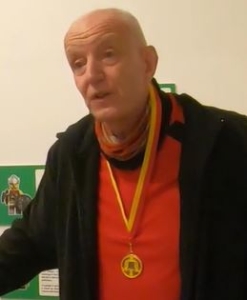 “Talking and telling stories about the fairies”: Manx Fairy Lore
“Talking and telling stories about the fairies”: Manx Fairy Lore
More than 100 people were present to enjoy this joint presentation by the Manx Branch of the Celtic Congress and Culture Vannin by Stephen Miller RBV.
The presentation was recorded by Culture Vannin and can be seen by clicking here.
Stephen gave his own outline of his presentation –
The Island has a remarkable store of fairy legends recorded first by George Waldron in the 1720s, followed by Edward Faragher and Karl Roeder in the 1890s, and the Manx Folk Life Survey in the 1940s. Forget about Tinkerbell and come and meet the Fairies, or as they were known, the Mooinjer-veggey, The Good People, The Little Gentry, Themselves, the Little People as well as the Lhiannan-shee and the Pynnodderree…
Stephen gave the first known reference to fairy law in the Manx archives with a Church Presentment for Kirk Andreas in 1665, of –
Phillip ffarcher, for Confessing that he himselfe was in the companie of the ffary Elves that night they came to Knock Doony when the good Wiffe was strucken with the ffairyes.
The Island was fortunate in the good services of George Waldron, who provides information about fairy lore in the Island from an earlier date than elsewhere. The unlikely friendship and partnership of crofter Edward Faragher of Cregneash and German-born, Manchester-based businessman Karl Roeder produced many glimpses of beliefs from the mid nineteenth century. The Folk Life Survey, started in 1948, shows how the telling of these tales of supernatural tales was a frequent entertainment in the late nineteenth and early twentieth century, but also a source of fear with people afraid to return home at night after hearing particularly chilling stories.
There was belief in a whole range of beings, with the ubiquitous fairies themselves more interested in stealing away babies and swapping them for their own, whereas other beings were associated with particular places, from the buggane to the tarroo ushtey and the dooinney oie. Some tales were very localised, probably based round phenomena in particular places, such as the Buggane of Gob-na-scute, bellowing away until a dislodged stone blocked his roar-producing throttle.
Stephen has been based in Vienna for a number of years and manages to get home only on an occasional basis, so it is very generous of him to give his time to sharing his wonderful breadth and depth of knowledge with us. As well as the interesting material he uncovers from his research, Stephen also has a happy knack of leavening his presentations with wit and humour.
Gura mie mooar ec Stephen for an interesting, entertaining and informative presentation.
